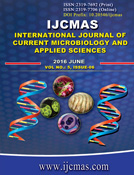


 National Academy of Agricultural Sciences (NAAS)
National Academy of Agricultural Sciences (NAAS)

|
PRINT ISSN : 2319-7692
Online ISSN : 2319-7706 Issues : 12 per year Publisher : Excellent Publishers Email : editorijcmas@gmail.com / submit@ijcmas.com Editor-in-chief: Dr.M.Prakash Index Copernicus ICV 2018: 95.39 NAAS RATING 2020: 5.38 |
Water pollution is one of the major problem in a todays scenario. Polluted water is a liberated from any industrial place or which contains a high amount of hazardous compounds. This water is discarded into waterbodies like river, lake, etc. These waterbodies are the source of water use for various purpose. If this polluted water is discarded directly into the waterbodies it can causes serious effect on environment and n human life. This type of water pollution can also affect the ecosystem adversely. So, analysis before release of water form industry is essential. Therefore, primary, secondary and final treatment of waste water is carried out. Physical, chemical and microbial analysis of waste water performed which includes pH, color, TDS, SS BOD, COD, oil and grease, chloride, sulphate, total coliform, fecal coliform, etc. Every industrial effluent contains high amount of organic matter which is hazardous to environment. Microorganisms use organic matter as a nutrient. Composition of waste water works as growth medium supplying sufficient nutrient for biological growth. The waste water plants are constructed to bring down the contamination level to acceptable quality level so that it can be easily discharged. Various physico-chemical techniques such as sedimentation, filtration, flotation, coagulation, etc. Have been studied in vast for waste water treatment but due to the limitation such as partial treatment, high cost, generation of secondary pollutants and use of chemical agents make the biological methods a favorable alternative for the removal of COD. Here, in my study, used Pseudomonas aeruginosa, Bacillus subtilis, Enterobactor aerogenes for COD reduction of pharmaceutical, textile, milk and food industrial waste water. Those organisms are highly efficient in COD reduction of industrial waste water up to 60-65% within few days.
 |
 |
 |
 |
 |